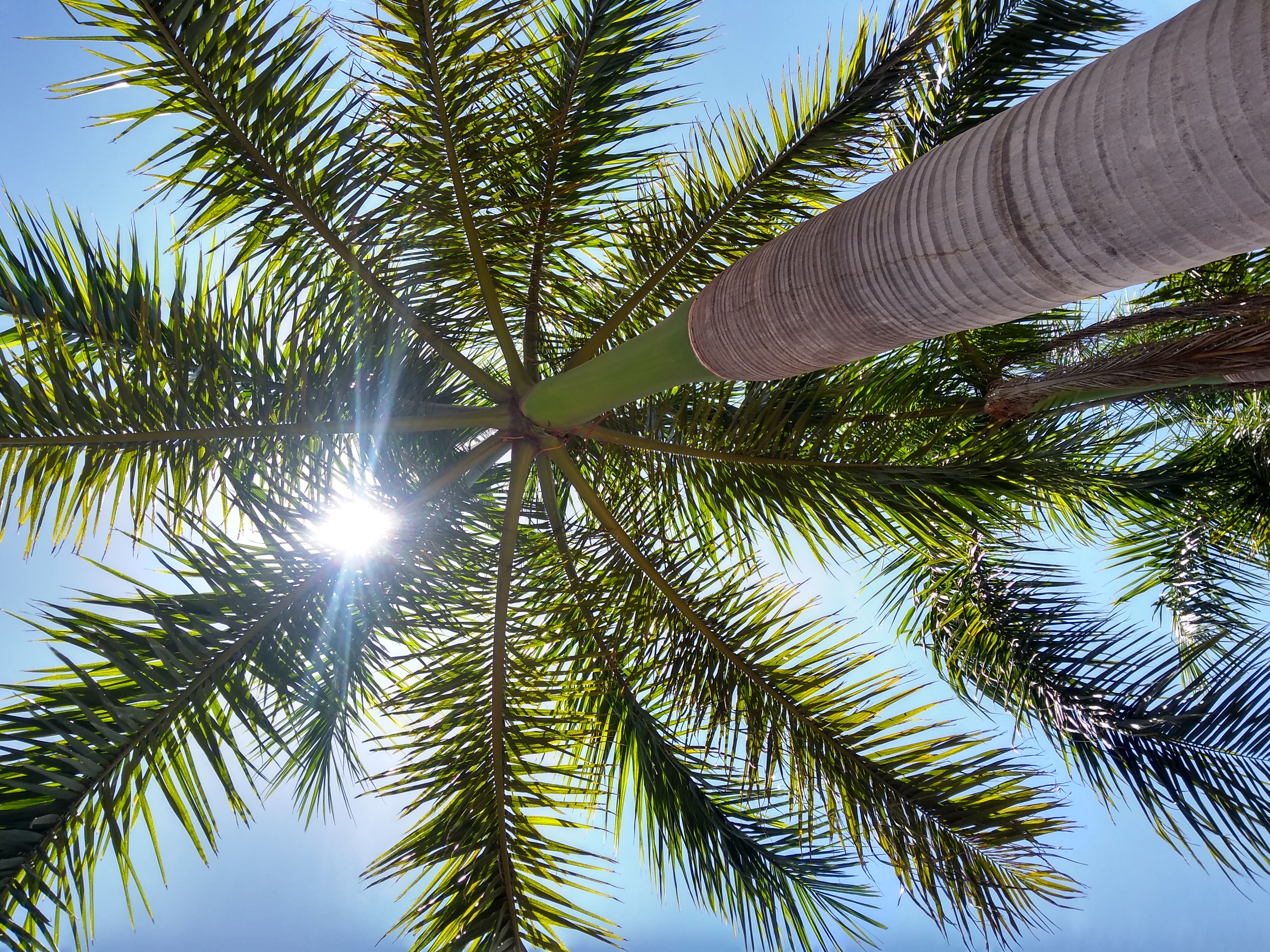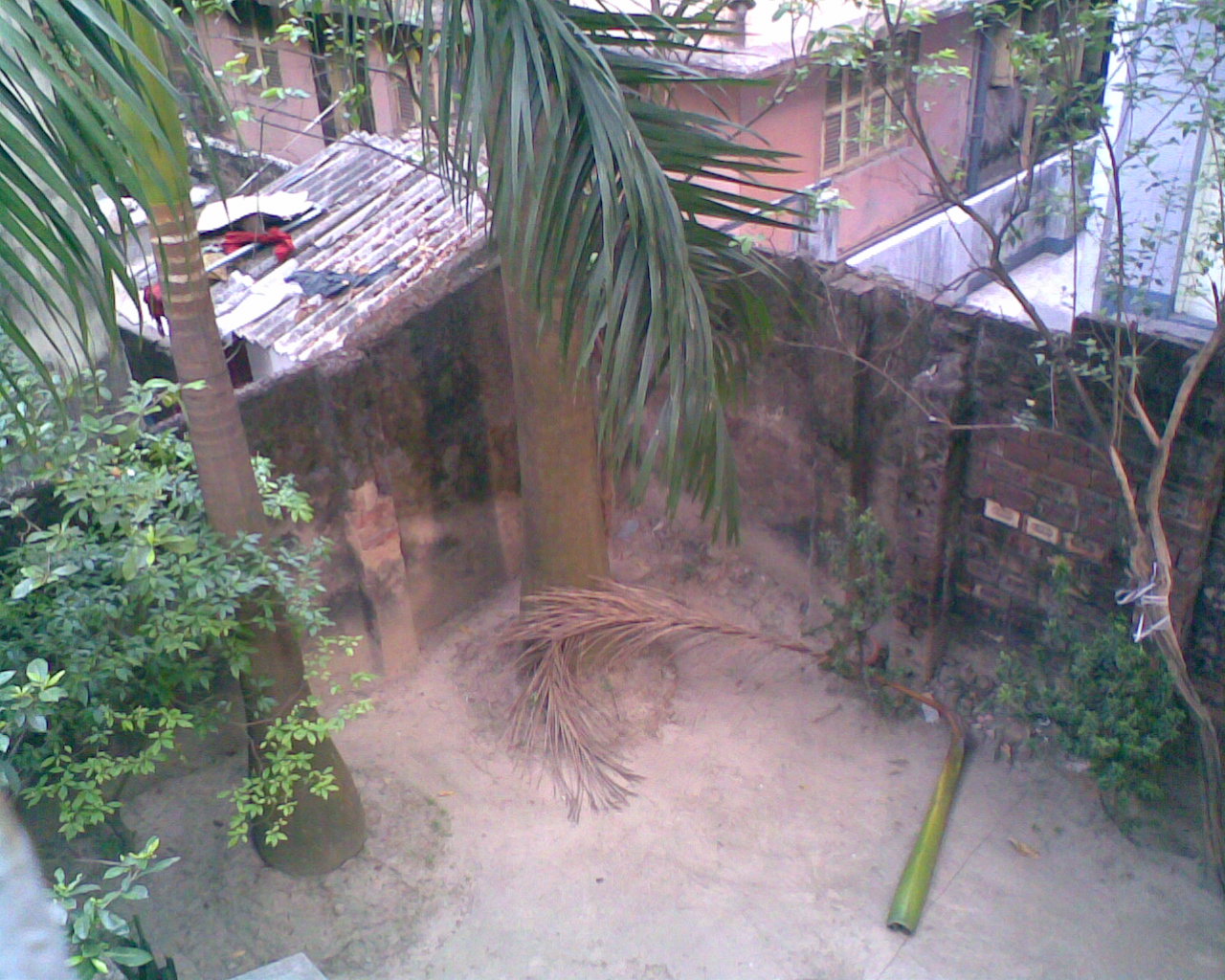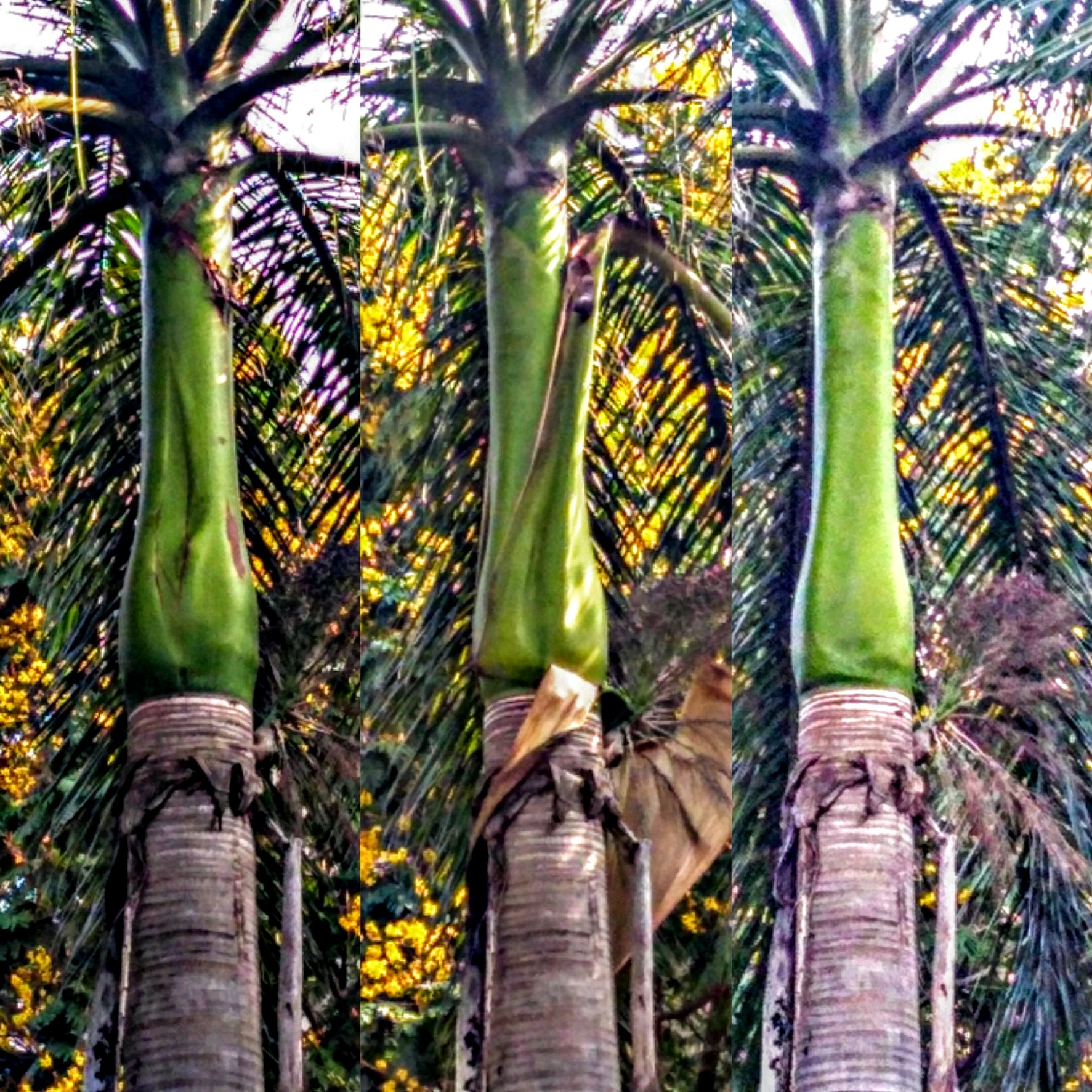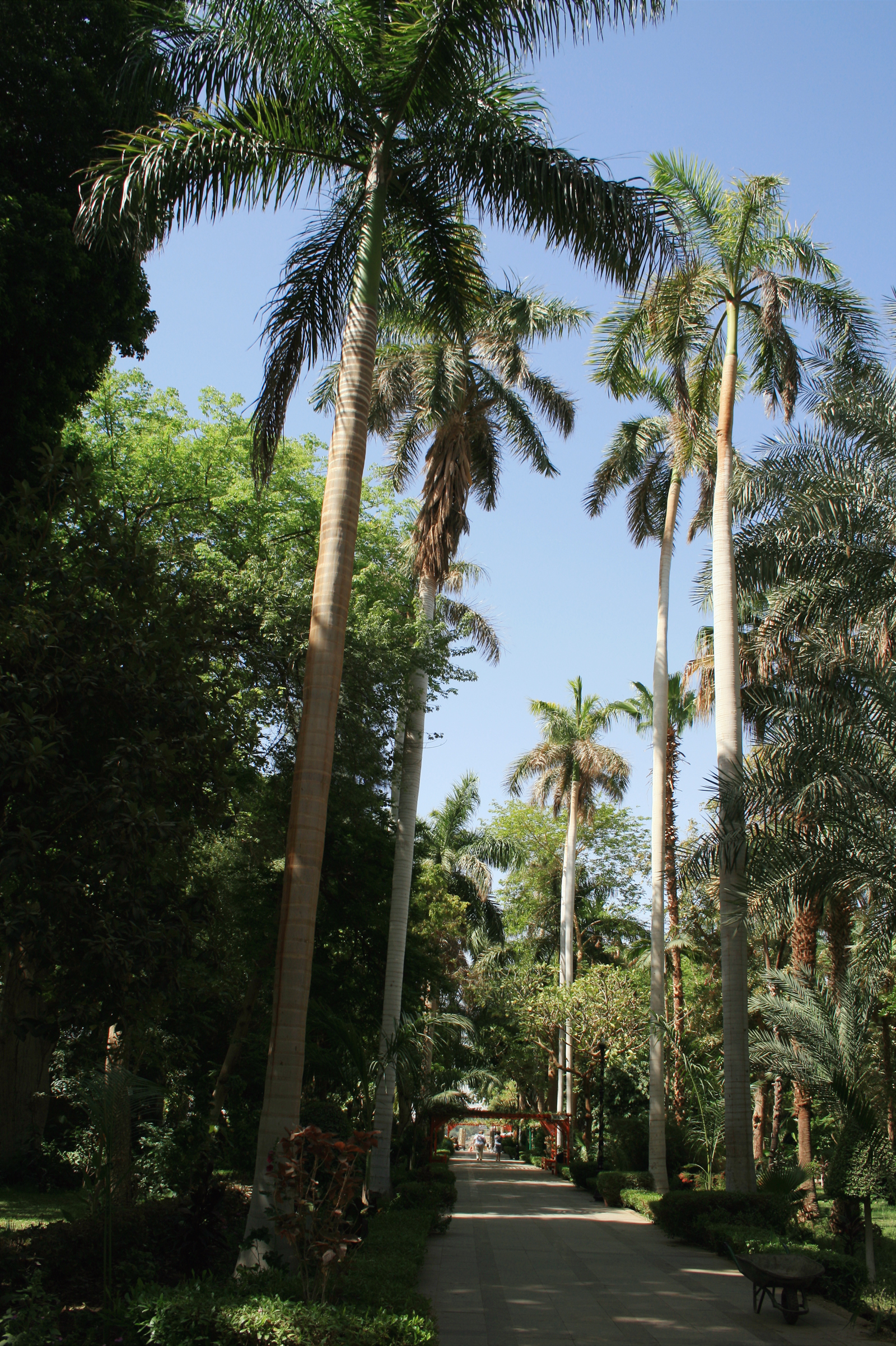Royal palm on:
[Wikipedia]
[Google]
[Amazon]
''Roystonea regia'', commonly known as the Cuban royal palm or Florida royal palm, is a species of

 ''Roystonea regia'' is a large palm which reaches a height of tall, (with heights up to reported) and a stem diameter of about . (K. F. Connor reports a maximum stem diameter of .) The trunk is stout, very smooth and grey-white in colour with a characteristic bulge below a distinctive green crownshaft. Trees have about 15 leaves which can be up to long. The flowers are white with pinkish anthers. The fruit are
''Roystonea regia'' is a large palm which reaches a height of tall, (with heights up to reported) and a stem diameter of about . (K. F. Connor reports a maximum stem diameter of .) The trunk is stout, very smooth and grey-white in colour with a characteristic bulge below a distinctive green crownshaft. Trees have about 15 leaves which can be up to long. The flowers are white with pinkish anthers. The fruit are

 Cook considered Floridian populations to be distinct from both the Cuba ''R. regia'' and the Puerto Rican '' R. borinquena'', and he placed them in a new species, ''R. floridana'', which is now considered a synonym of ''R. regia''. In 1906
Cook considered Floridian populations to be distinct from both the Cuba ''R. regia'' and the Puerto Rican '' R. borinquena'', and he placed them in a new species, ''R. floridana'', which is now considered a synonym of ''R. regia''. In 1906

 ''Roystonea regia'' produces
''Roystonea regia'' produces

palm
Palm most commonly refers to:
* Palm of the hand, the central region of the front of the hand
* Palm plants, of family Arecaceae
**List of Arecaceae genera
* Several other plants known as "palm"
Palm or Palms may also refer to:
Music
* Palm (ba ...
that is native to Mexico, parts of Central America and the Caribbean, and southern Florida
South Florida is the southernmost region of the U.S. state of Florida. It is one of Florida's three most commonly referred to directional regions; the other two are Central Florida and North Florida. South Florida is the southernmost part of th ...
. A large and attractive palm, it has been planted throughout the tropics and subtropics as an ornamental tree. Although it is sometimes called ''R. elata'', the conserved name ''R. regia'' is now the correct name for the species. The royal palm reaches heights from 50 to over 80 feet tall. Populations in Cuba
Cuba ( , ), officially the Republic of Cuba ( es, República de Cuba, links=no ), is an island country comprising the island of Cuba, as well as Isla de la Juventud and several minor archipelagos. Cuba is located where the northern Caribbea ...
and Florida
Florida is a state located in the Southeastern region of the United States. Florida is bordered to the west by the Gulf of Mexico, to the northwest by Alabama, to the north by Georgia, to the east by the Bahamas and Atlantic Ocean, and to ...
were long seen as separate species, but are now considered a single species.
Widely planted as an ornamental, ''R. regia'' is also used for thatch, construction timber, and in some forms of so-called traditional medicine, although there is currently no valid scientific evidence to support the efficacy or use of any palm species for medicinal purposes. The fruit is eaten by birds and bats (which disperse the seeds) and fed to livestock. Its flowers are visited by birds and bats, and it serves as a roosting site and food source for a variety of animals. ''Roystonea regia'' is the national tree
This is a list of national trees, most official, but some unofficial.
National trees
See also
* National emblem
* Floral emblem
* List of U.S. State and territory trees
References
{{DEFAULTSORT:List Of National Trees
N
Trees
In ...
of Cuba
Cuba ( , ), officially the Republic of Cuba ( es, República de Cuba, links=no ), is an island country comprising the island of Cuba, as well as Isla de la Juventud and several minor archipelagos. Cuba is located where the northern Caribbea ...
, and has a religious role both in Santería and Christianity, where it is used in Palm Sunday
Palm Sunday is a Christian moveable feast that falls on the Sunday before Easter. The feast commemorates Christ's triumphal entry into Jerusalem, an event mentioned in each of the four canonical Gospels. Palm Sunday marks the first day of Hol ...
observances.
Description

 ''Roystonea regia'' is a large palm which reaches a height of tall, (with heights up to reported) and a stem diameter of about . (K. F. Connor reports a maximum stem diameter of .) The trunk is stout, very smooth and grey-white in colour with a characteristic bulge below a distinctive green crownshaft. Trees have about 15 leaves which can be up to long. The flowers are white with pinkish anthers. The fruit are
''Roystonea regia'' is a large palm which reaches a height of tall, (with heights up to reported) and a stem diameter of about . (K. F. Connor reports a maximum stem diameter of .) The trunk is stout, very smooth and grey-white in colour with a characteristic bulge below a distinctive green crownshaft. Trees have about 15 leaves which can be up to long. The flowers are white with pinkish anthers. The fruit are spheroid
A spheroid, also known as an ellipsoid of revolution or rotational ellipsoid, is a quadric surface obtained by rotating an ellipse about one of its principal axes; in other words, an ellipsoid with two equal semi-diameters. A spheroid has ...
to ellipsoid in shape, long and wide. They are green when immature, turning red and eventually purplish-black as they mature.
Root nodules containing ''Rhizobium
''Rhizobium'' is a genus of Gram-negative soil bacteria that fix nitrogen. ''Rhizobium'' species form an endosymbiotic nitrogen-fixing association with roots of (primarily) legumes and other flowering plants.
The bacteria colonize plant cells ...
'' bacteria have been found on ''R. regia'' trees in India
India, officially the Republic of India (Hindi: ), is a country in South Asia. It is the seventh-largest country by area, the second-most populous country, and the most populous democracy in the world. Bounded by the Indian Ocean on the so ...
. The presence of rhizobia-containing root nodules is usually associated with nitrogen fixation
Nitrogen fixation is a chemical process by which molecular nitrogen (), with a strong triple covalent bond, in the air is converted into ammonia () or related nitrogenous compounds, typically in soil or aquatic systems but also in industry. Atmo ...
in legumes; this was the first record of root nodules in a monocotyledon
Monocotyledons (), commonly referred to as monocots, (Lilianae ''sensu'' Chase & Reveal) are grass and grass-like flowering plants (angiosperms), the seeds of which typically contain only one embryonic leaf, or cotyledon. They constitute one of ...
ous tree. Further evidence of nitrogen fixation was provided by the presence of nitrogenase
Nitrogenases are enzymes () that are produced by certain bacteria, such as cyanobacteria (blue-green bacteria) and rhizobacteria. These enzymes are responsible for the reduction of nitrogen (N2) to ammonia (NH3). Nitrogenases are the only fa ...
(an enzyme used in nitrogen fixation) and leghaemoglobin
3rd Leghemoglobin (also leghaemoglobin or legoglobin) is an oxygen-carrying phytoglobin found in the nitrogen-fixing root nodules of leguminous plants. It is produced by these plants in response to the roots being colonized by nitrogen-fixing ...
, a compound which allows nitrogenase to function by reducing the oxygen concentration in the root nodule. In addition to evidence of nitrogen fixation, the nodules were also found to be producing indole acetic acid
Indole-3-acetic acid (IAA, 3-IAA) is the most common naturally occurring plant hormone of the auxin class. It is the best known of the auxins, and has been the subject of extensive studies by plant physiologists. IAA is a derivative of indole, con ...
, an important plant hormone.
Taxonomy
''Roystonea'' is placed in the subfamily Arecoideae and thetribe
The term tribe is used in many different contexts to refer to a category of human social group. The predominant worldwide usage of the term in English is in the discipline of anthropology. This definition is contested, in part due to confli ...
Roystoneae. The placement ''Roystonea'' within the Arecoideae is uncertain; a phylogeny
A phylogenetic tree (also phylogeny or evolutionary tree Felsenstein J. (2004). ''Inferring Phylogenies'' Sinauer Associates: Sunderland, MA.) is a branching diagram or a tree showing the evolutionary relationships among various biological spe ...
based on plastid DNA failed to resolve the position of the genus within the Arecoideae. As of 2008, there appear to be no molecular phylogenetic studies of ''Roystonea'' and the relationship between ''R. regia'' and the rest of the genus is uncertain.
The species was first described by American naturalist William Bartram in 1791 as ''Palma elata'' based on trees growing in central Florida. In 1816 German
German(s) may refer to:
* Germany (of or related to)
** Germania (historical use)
* Germans, citizens of Germany, people of German ancestry, or native speakers of the German language
** For citizens of Germany, see also German nationality law
**Ge ...
botanist Carl Sigismund Kunth
Carl Sigismund Kunth (18 June 1788 – 22 March 1850), also Karl Sigismund Kunth or anglicized as Charles Sigismund Kunth, was a German botanist. He is known for being one of the first to study and categorise plants from the American continents, ...
described the species ''Oreodoxa regia'' based on collections made by Alexander von Humboldt
Friedrich Wilhelm Heinrich Alexander von Humboldt (14 September 17696 May 1859) was a German polymath, geographer, naturalist, explorer, and proponent of Romantic philosophy and science. He was the younger brother of the Prussian minister, ...
and Aimé Bonpland
Aimé Jacques Alexandre Bonpland (; 22 August 1773 – 11 May 1858) was a French explorer and botanist who traveled with Alexander von Humboldt in Latin America from 1799 to 1804. He co-authored volumes of the scientific results of their ex ...
in Cuba
Cuba ( , ), officially the Republic of Cuba ( es, República de Cuba, links=no ), is an island country comprising the island of Cuba, as well as Isla de la Juventud and several minor archipelagos. Cuba is located where the northern Caribbea ...
. In 1825 German botanist Curt Polycarp Joachim Sprengel
Kurt Polycarp Joachim Sprengel (3 August 1766 – 15 March 1833) was a German botanist and physician who published an influential multivolume history of medicine, ''Versuch einer pragmatischen Geschichte der Arzneikunde'' (1792–99 in four vo ...
moved it to the genus ''Oenocarpus
''Oenocarpus'' is a genus of pinnate-leaved palms (Arecaceae) native to Trinidad, southern Central and tropical South America. (2004): World Checklist of Arecaceae &ndash''Oenocarpus'' The Board of Trustees of the Royal Botanic Gardens, Kew. Re ...
'' and renamed it ''O. regius''.
The genus ''Oreodoxa'' was proposed by German botanist Carl Ludwig Willdenow
Carl Ludwig Willdenow (22 August 1765 – 10 July 1812) was a German botanist, pharmacist, and plant taxonomist. He is considered one of the founders of phytogeography, the study of the geographic distribution of plants. Willdenow was al ...
in 1807 and applied by him to two species, ''O. acuminata'' (now known as '' Prestoea acuminata'') and ''O. praemorsa'' (now '' Wettinia praemorsa''). Although these species were transferred to other genera, the genus ''Oreodoxa'' continued to be applied to a variety of superficially similar species which were not, in fact, closely related. To address this problem, American botanist Orator F. Cook created the genus ''Roystonea'', which he named in honour of American general Roy Stone
Roy Stone (October 16, 1836 – August 5, 1905) was an American soldier, civil engineer, and inventor. He served in the American Civil War, distinguishing himself during the Battle of Gettysburg, and took part in the Spanish–American War. He ...
, and renamed Kunth's species ''Roystonea regia''.

 Cook considered Floridian populations to be distinct from both the Cuba ''R. regia'' and the Puerto Rican '' R. borinquena'', and he placed them in a new species, ''R. floridana'', which is now considered a synonym of ''R. regia''. In 1906
Cook considered Floridian populations to be distinct from both the Cuba ''R. regia'' and the Puerto Rican '' R. borinquena'', and he placed them in a new species, ''R. floridana'', which is now considered a synonym of ''R. regia''. In 1906 Charles Henry Wright
Charles is a masculine given name predominantly found in English language, English and French language, French speaking countries. It is from the French form ''Charles'' of the Proto-Germanic, Proto-Germanic name (in runic alphabet) or ''*k ...
described two new species based on collections from Georgetown, British Guiana (now Guyana) which he placed in the genus '' Euterpe'' — ''E. jenmanii'' and ''E. ventricosa''. Both species are now considered synonyms of ''R. regia''. The name ''R. regia'' var. ''hondurensis'' was applied by Paul H. Allen to Central American populations of the species. However, Scott Zona determined that they did not differ enough from Cuban populations to be considered a separate variety
Variety may refer to:
Arts and entertainment Entertainment formats
* Variety (radio)
* Variety show, in theater and television
Films
* ''Variety'' (1925 film), a German silent film directed by Ewald Andre Dupont
* ''Variety'' (1935 film), ...
.
Based on the rules of botanical nomenclature, the oldest properly published name for a species has priority over newer names. Bartram applied the Linnaean binomial ''Palma elata'' to a "large, solitary palm with an ashen white trunk topped by a green leaf sheath he crownshaftand pinnate leaves" growing in central Florida. While no type collection is known, there are no other native palms that would fit Bartram's description. In 1946 Francis Harper pointed out that Bartram's name was valid and proposed a new combination, ''Roystonea elata''. Liberty Hyde Bailey's use of the name in his 1949 revision of the genus, established its usage.
Harper's new combination immediately supplanted Cook's ''R. floridana'', but there was disagreement as to whether Cuban and Floridian populations represented a single species or two species. Zona's revision of the genus concluded that they both belonged to the same species. According to the rules of botanical nomenclature, the correct name of the species should have been ''Roystonea elata''. Zona pointed out, however, that the name ''R. regia'' (or ''Oreodoxa regia'') has a history of use in horticulture that dated from at least 1838, and that the species had been propagated around the world under that name. ''Roystonea elata'', on the other hand, had only been used since 1949, and was used much less widely. On that basis, Zona proposed that the name ''Roystonea regia'' should be conserved.
Common names
In cultivation, ''Roystonea regia'' is called the Cuban royal palm or simply the royal palm. In Cuba, the tree is called the ''palma real'' or ''palma criolla''. In India, where it is widely cultivated, it is called ''vakka''. In Cambodia, where it is planted as decorative along avenues and in public parks, it is known as ''sla barang ("Western palm").Reproduction and growth

 ''Roystonea regia'' produces
''Roystonea regia'' produces
unisexual flowers
Plant reproductive morphology is the study of the physical form and structure (the morphology) of those parts of plants directly or indirectly concerned with sexual reproduction.
Among all living organisms, flowers, which are the reproductive st ...
that are pollinated
Pollination is the transfer of pollen from an anther of a plant to the stigma of a plant, later enabling fertilisation and the production of seeds, most often by an animal or by wind. Pollinating agents can be animals such as insects, birds, a ...
by animals. European honey bee
The western honey bee or European honey bee (''Apis mellifera'') is the most common of the 7–12 species of honey bees worldwide. The genus name ''Apis'' is Latin for "bee", and ''mellifera'' is the Latin for "honey-bearing" or "honey carrying", ...
s and bats are reported pollinators. Seeds are dispersed by birds and bats that feed upon the fruit.
Seed germination is adjacent ligular—during germination, as the cotyledon
A cotyledon (; ; ; , gen. (), ) is a significant part of the embryo within the seed of a plant, and is defined as "the embryonic leaf in seed-bearing plants, one or more of which are the first to appear from a germinating seed." The num ...
expands it only pushes a portion of the embryo out of the seed. As a result, the seedling develops adjacent to the seed. The embryo forms a ligule, and the plumule protrudes from this. Seedlings in cultivation are reported to begin producing a stem two years after germination, at the point where they produce their thirteenth leaf. Growth rates of seedlings averaged per year in Florida.Jones, Julie Lynn. 1983. An Ecological Study of the Florida Royal Palm, ''Roystonea elata''. M.S. Thesis. Florida Atlantic University.
Distribution and habitat
''Roystonea regia'' is found inCentral America
Central America ( es, América Central or ) is a subregion of the Americas. Its boundaries are defined as bordering the United States to the north, Colombia to the south, the Caribbean Sea to the east, and the Pacific Ocean to the west. ...
, Cuba, the Cayman Islands, Hispaniola (the Dominican Republic
The Dominican Republic ( ; es, República Dominicana, ) is a country located on the island of Hispaniola in the Greater Antilles archipelago of the Caribbean region. It occupies the eastern five-eighths of the island, which it shares with ...
and Haiti), the Lesser Antilles
The Lesser Antilles ( es, link=no, Antillas Menores; french: link=no, Petites Antilles; pap, Antias Menor; nl, Kleine Antillen) are a group of islands in the Caribbean Sea. Most of them are part of a long, partially volcanic island arc bet ...
, The Bahamas
The Bahamas (), officially the Commonwealth of The Bahamas, is an island country within the Lucayan Archipelago of the West Indies in the North Atlantic. It takes up 97% of the Lucayan Archipelago's land area and is home to 88% of the ar ...
, southern Florida
Florida is a state located in the Southeastern region of the United States. Florida is bordered to the west by the Gulf of Mexico, to the northwest by Alabama, to the north by Georgia, to the east by the Bahamas and Atlantic Ocean, and to ...
, and Mexico
Mexico (Spanish: México), officially the United Mexican States, is a country in the southern portion of North America. It is bordered to the north by the United States; to the south and west by the Pacific Ocean; to the southeast by Guatema ...
(Veracruz
Veracruz (), formally Veracruz de Ignacio de la Llave (), officially the Free and Sovereign State of Veracruz de Ignacio de la Llave ( es, Estado Libre y Soberano de Veracruz de Ignacio de la Llave), is one of the 31 states which, along with Me ...
, Campeche, Quintana Roo, Yucatán (state), Yucatán). William Bartram described the species from Lake Dexter (Polk County, Florida), Lake Dexter, along the St. Johns River in the area of modern Lake County, Florida, Lake and Volusia County, Florida, Volusia Counties in central Florida, an area north of its modern range.
''Roystonea regia'' is most abundant in Cuba, where is occurs on hillsides and valleys. In southern Florida
South Florida is the southernmost region of the U.S. state of Florida. It is one of Florida's three most commonly referred to directional regions; the other two are Central Florida and North Florida. South Florida is the southernmost part of th ...
, ''Roystonea regia'' occurs in strand swamps and tropical hardwood hammock, hardwood hammocks.
''Roystonea'' is cultivated in tropical and subtropical climates in the United States, Australia, Brazil, and parts of southern Asia as a landscape palm. It appears to naturalise with ease, and extensive naturalised populations are present in Panama, Costa Rica, and Guyana. In the United States it grows mostly in central and southern Florida, Hawaii, Puerto Rico, and in South Texas in the Lower Rio Grande Valley, Rio Grande Valley and southern California.

Ecology
The leaves of ''Roystonea regia'' are used as roosting sites by ''Eumops floridanus'', the Florida bonneted bat, and is used as a retreat for Cuban tree frogs (''Osteopilus septentriolalis''), a non-native species, in Florida. In Panama (where ''R. regia'' is introduced), its trunks are used as nesting sites by yellow-crowned parrots (''yellow-crowned amazon, Amazona ochrocephala panamensis''). The flowers of ''R. regia'' are visited by pollen-collecting bees and are considered a good source of nectar. Its pollen was also found in the stomachs of ''Cuban flower bat, Phyllonycteris poeyi'', the Cuban flower bat (a pollen-feeder) and ''Leach's single leaf bat, Monophyllus redmani'', Leach's single leaf bat (a nectar-feeder). ''Artibeus jamaicensis'', the Jamaican fruit bat, and ''Myiozetetes similis'', the social flycatcher, feed on the fruit. ''Roystonea regia'' is the host plant for the royal palm bug, ''Xylastodoris luteolus'', in Florida. It also serves as a larval host plant for the butterflies ''Pyrrhocalles antiqua, Pyrrhocalles antiqua orientis'' and ''Asbolis capucinus'' in Cuba, and ''Brassolis astyra'' and ''Brassolis sophorae, B. sophorae'' in Brazil. It is susceptible to bud rot caused by the oomycete ''Phytophthora palmivora'' and by the fungus ''Ceratocystis paradoxa, Thielaviopsis paradoxa''. The species is considered an invasive species in secondary forest in Panama.Uses
''Roystonea regia'' has been planted throughout the tropics and subtropics as an ornamental. The seed is used as a source of oil and for livestock feed. Leaves are used for thatching and the wood for construction. The roots are used as a diuretic, and for that reason they are added to ''tifey'', a Haitian drink, by Cubans of Haitian origin. They are also used as a treatment for diabetes mellitus, diabetes. Fibres extracted from the leaf sheath of ''R. regia'' have been found to be comparable with sisal and banana fibres, but lower in density, making it a potentially useful source for the use in lightweight composite materials. An extract from ''R. regia'' fruit known as D-004 reduces benign prostatic hyperplasia, benign prostate hyperplasia (BPH) in rodents. D-004, is a mixture of fatty acids, is being studied as a potential alternative to finasteride for the treatment of BPH.Religious significance
''Roystonea regia'' plays an important role in popular religion in Cuba. In Santería it is associated primarily with Shango or with his father Aganju, Aggayú. It also has symbolic importance in the Palo (religion), Palo faiths and the Abakuá fraternity. In Catholic Church, Roman Catholicism, ''R. regia'' plays an important role inPalm Sunday
Palm Sunday is a Christian moveable feast that falls on the Sunday before Easter. The feast commemorates Christ's triumphal entry into Jerusalem, an event mentioned in each of the four canonical Gospels. Palm Sunday marks the first day of Hol ...
observances.
References
External links
* * http://www.palmpedia.net/wiki/Roystonea_regia {{Taxonbar, from=Q1069046 Roystonea, regia Trees of the Southeastern United States Trees of Mexico Trees of Central America Trees of the Caribbean National symbols of Cuba Plants described in 1791